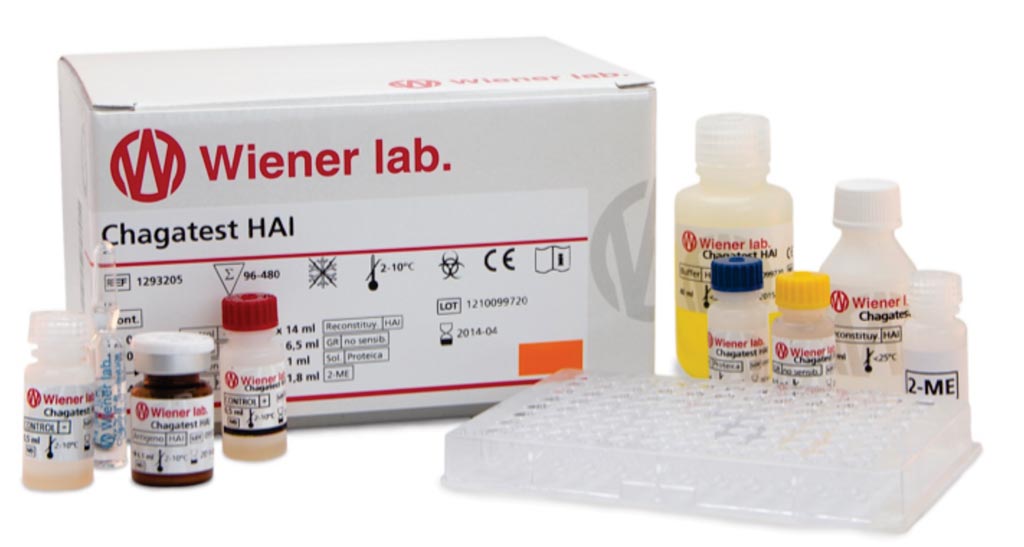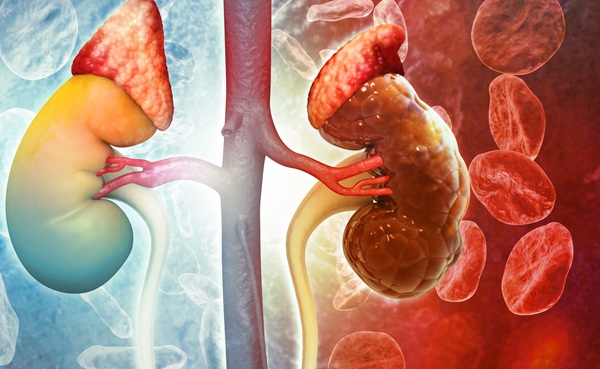Immunoassays Compared to Improve Diagnosis of Chagas Disease
|
By LabMedica International staff writers Posted on 26 Oct 2019 |

Image: Indirect hemagglutination test for the detection of antibodies against Trypanosoma cruzi (Photo courtesy of Wiener lab. Group).
Chagas disease (CD), caused by the protozoan Trypanosoma cruzi, is a vector-borne infection of significant public health concern in Latin America, where nearly six million people are infected and 70 million are at risk of infection.
Up to 99% of CD cases in the Americas and more than 90% in Europe are undiagnosed. A key barrier is the complexity of the diagnostic process, which is hampered by the lack of a gold standard, availability of multiple types of assays with varying sensitivity and specificity, and the sheer difficulty of detecting the parasite in the chronic phase of the disease.
Scientists associated the Colombian National Institute of Health (Bogota, Colombia) used a panel of 501 serum samples obtained from whole blood and the samples reflected a broad spectrum of CD patients in Colombia. Patients ranged in age from 1 to 81, but only seven were under 18 years old. Mean patient age was 39.3 years and was younger in blood donors (22.3) than patients tested in public health laboratories (49.4).
Samples were characterized as positive (n = 256) or negative (n = 245) using standard procedures based on four serological assays: an in-house enzyme-linked immunosorbent assay (ELISA), optic density ≥ 0.300; an in-house immunofluorescence assay (IFA), dilution ≥ 1:32; an indirect hemagglutination; and immunoblots of trypomastigote excreted-secreted antigens.
The scientists assessed seven commercially available assays and found that five of seven assays exhibited sensitivity >98% while six showed specificity >97%. A total antigen ELISA paired with a recombinant assay provided similar performance to the current diagnostic process. Six of six assays tested proved capable of detecting different Trypanosoma cruzi genetic lineages. Of the 501 samples, 85.2% were correctly classified by all seven immunoassays; 222/256 positive samples (86.7%) and 202/245 (83.7%) negative samples.
The authors concluded that their study demonstrated the utility of systematically evaluating T. cruzi assays, using WHO standards, to validate national guidelines for CD diagnosis, strengthen quality control of diagnostic tools, and promote international standardization. A simplified testing process with two commercial assays could perform comparably to the previous process, reducing cost and accessibility barriers and facilitating national scale-up. The study was published in the October 2019 issue of the International Journal of Infectious Diseases.
Related Links:
Colombian National Institute of Health
Up to 99% of CD cases in the Americas and more than 90% in Europe are undiagnosed. A key barrier is the complexity of the diagnostic process, which is hampered by the lack of a gold standard, availability of multiple types of assays with varying sensitivity and specificity, and the sheer difficulty of detecting the parasite in the chronic phase of the disease.
Scientists associated the Colombian National Institute of Health (Bogota, Colombia) used a panel of 501 serum samples obtained from whole blood and the samples reflected a broad spectrum of CD patients in Colombia. Patients ranged in age from 1 to 81, but only seven were under 18 years old. Mean patient age was 39.3 years and was younger in blood donors (22.3) than patients tested in public health laboratories (49.4).
Samples were characterized as positive (n = 256) or negative (n = 245) using standard procedures based on four serological assays: an in-house enzyme-linked immunosorbent assay (ELISA), optic density ≥ 0.300; an in-house immunofluorescence assay (IFA), dilution ≥ 1:32; an indirect hemagglutination; and immunoblots of trypomastigote excreted-secreted antigens.
The scientists assessed seven commercially available assays and found that five of seven assays exhibited sensitivity >98% while six showed specificity >97%. A total antigen ELISA paired with a recombinant assay provided similar performance to the current diagnostic process. Six of six assays tested proved capable of detecting different Trypanosoma cruzi genetic lineages. Of the 501 samples, 85.2% were correctly classified by all seven immunoassays; 222/256 positive samples (86.7%) and 202/245 (83.7%) negative samples.
The authors concluded that their study demonstrated the utility of systematically evaluating T. cruzi assays, using WHO standards, to validate national guidelines for CD diagnosis, strengthen quality control of diagnostic tools, and promote international standardization. A simplified testing process with two commercial assays could perform comparably to the previous process, reducing cost and accessibility barriers and facilitating national scale-up. The study was published in the October 2019 issue of the International Journal of Infectious Diseases.
Related Links:
Colombian National Institute of Health
Latest Microbiology News
- Blood-Based Diagnostic Method Could Identify Pediatric LRTIs
- Rapid Diagnostic Test Matches Gold Standard for Sepsis Detection
- Rapid POC Tuberculosis Test Provides Results Within 15 Minutes
- Rapid Assay Identifies Bloodstream Infection Pathogens Directly from Patient Samples
- Blood-Based Molecular Signatures to Enable Rapid EPTB Diagnosis
- 15-Minute Blood Test Diagnoses Life-Threatening Infections in Children
- High-Throughput Enteric Panels Detect Multiple GI Bacterial Infections from Single Stool Swab Sample
- Fast Noninvasive Bedside Test Uses Sugar Fingerprint to Detect Fungal Infections
- Rapid Sepsis Diagnostic Device to Enable Personalized Critical Care for ICU Patients
- Microfluidic Platform Assesses Neutrophil Function in Sepsis Patients
- New Diagnostic Method Confirms Sepsis Infections Earlier
- New Markers Could Predict Risk of Severe Chlamydia Infection
- Portable Spectroscopy Rapidly and Noninvasively Detects Bacterial Species in Vaginal Fluid
- CRISPR-Based Saliva Test Detects Tuberculosis Directly from Sputum
- Urine-Based Assay Diagnoses Common Lung Infection in Immunocompromised People
- Saliva Test Detects Implant-Related Microbial Risks
Channels
Clinical Chemistry
view channel
POC Breath Diagnostic System to Detect Pneumonia-Causing Pathogens
Pseudomonas aeruginosa is a major cause of hospital-acquired and ventilator-associated pneumonia, particularly in lung transplant recipients and patients with structural lung disease. Its ability to form... Read more
Online Tool Detects Drug Exposure Directly from Patient Samples
Doctors often rely on patient interviews and medical records to determine what medications a person has taken, but this information is frequently incomplete. People may forget drugs they used, take over-the-counter... Read moreMolecular Diagnostics
view channel
Blood Biomarker Improves Early Brain Injury Prognosis After Cardiac Arrest
After a cardiac arrest, many patients remain unconscious for days, leaving doctors and families facing uncertainty about whether meaningful recovery is possible. Current tools to assess brain damage, including... Read more
Biomarkers Could Identify Patients at High Risk of Severe AKI After Major Surgery
Acute kidney injury is one of the most common and dangerous complications after major surgery, particularly among patients in intensive care. Even mild impairment of kidney function can lead to long-term... Read more
CLIA Test Identifies Head and Neck Cancer Recurrence from Post-Surgical Lymphatic Fluid
While the lymphatic system’s critical role in metastasis has long been recognized, routine access to patient lymph has been elusive. Now, a non-invasive process can access lymph through the collection... Read moreHematology
view channel
MRD Tests Could Predict Survival in Leukemia Patients
Acute myeloid leukemia is an aggressive blood cancer that disrupts normal blood cell production and often relapses even after intensive treatment. Clinicians currently lack early, reliable markers to predict... Read more
Platelet Activity Blood Test in Middle Age Could Identify Early Alzheimer’s Risk
Early detection of Alzheimer’s disease remains one of the biggest unmet needs in neurology, particularly because the biological changes underlying the disorder begin decades before memory symptoms appear.... Read more
Microvesicles Measurement Could Detect Vascular Injury in Sickle Cell Disease Patients
Assessing disease severity in sickle cell disease (SCD) remains challenging, especially when trying to predict hemolysis, vascular injury, and risk of complications such as vaso-occlusive crises.... Read more
ADLM’s New Coagulation Testing Guidance to Improve Care for Patients on Blood Thinners
Direct oral anticoagulants (DOACs) are one of the most common types of blood thinners. Patients take them to prevent a host of complications that could arise from blood clotting, including stroke, deep... Read moreMicrobiology
view channel
Blood-Based Diagnostic Method Could Identify Pediatric LRTIs
Lower-respiratory tract infections (LRTIs) are a leading cause of illness and death worldwide, and pneumonia is the leading infectious cause of death in children under five, claiming the lives of over... Read more
Rapid Diagnostic Test Matches Gold Standard for Sepsis Detection
Sepsis kills 11 million people worldwide every year and generates massive healthcare costs. In the USA and Europe alone, sepsis accounts for USD 100 billion in annual hospitalization expenses.... Read moreRapid POC Tuberculosis Test Provides Results Within 15 Minutes
Tuberculosis remains one of the world’s deadliest infectious diseases, and reducing new cases depends on identifying individuals with latent infection before it progresses. Current diagnostic tools often... Read more
Rapid Assay Identifies Bloodstream Infection Pathogens Directly from Patient Samples
Bloodstream infections in sepsis progress quickly and demand rapid, precise diagnosis. Current blood-culture methods often take one to five days to identify the pathogen, leaving clinicians to treat blindly... Read morePathology
view channel
Rapid Low-Cost Tests Can Prevent Child Deaths from Contaminated Medicinal Syrups
Medicinal syrups contaminated with toxic chemicals have caused the deaths of hundreds of children worldwide, exposing a critical gap in how these products are tested before reaching patients.... Read more
Tumor Signals in Saliva and Blood Enable Non-Invasive Monitoring of Head and Neck Cancer
Head and neck cancers are among the most aggressive malignancies worldwide, with nearly 900,000 new cases diagnosed each year. Monitoring these cancers for recurrence or relapse typically relies on tissue... Read more
Common Health Issues Can Influence New Blood Tests for Alzheimer’s Disease
Blood-based tests for Alzheimer’s disease are transforming diagnosis by offering a simpler alternative to spinal taps and brain imaging. However, many people evaluated at memory clinics also live with... Read more
Blood Test Formula Identifies Chronic Liver Disease Patients with Higher Cancer Risk
Chronic liver disease affects millions worldwide and can progress silently to hepatocellular carcinoma (HCC), one of the deadliest cancers globally. While surveillance guidelines exist for patients with... Read moreTechnology
view channel
Machine Learning Models Diagnose ALS Earlier Through Blood Biomarkers
Amyotrophic lateral sclerosis (ALS) is a rapidly progressive neurodegenerative disease that is notoriously difficult to diagnose in its early stages. Early symptoms often overlap with other neurological... Read more
Artificial Intelligence Model Could Accelerate Rare Disease Diagnosis
Identifying which genetic variants actually cause disease remains one of the biggest challenges in genomic medicine. Each person carries tens of thousands of DNA changes, yet only a few meaningfully alter... Read moreIndustry
view channel
BD and Penn Institute Collaborate to Advance Immunotherapy through Flow Cytometry
BD (Becton, Dickinson and Company, Franklin Lakes, NJ, USA) has entered into a strategic collaboration with the Institute for Immunology and Immune Health (I3H, Philadelphia, PA, USA) at the University... Read more




 assay.jpg)













